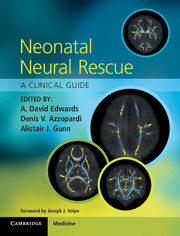Book contents
- Frontmatter
- Contents
- List of contributors
- Foreword
- Section 1 Scientific background
- Section 2 Clinical neural rescue
- 6 Challenges for parents and clinicians discussing neuroprotective treatments
- 7 The pharmacology of hypothermia
- 8 Selection of infants for hypothermic neural rescue
- 9 Hypothermia during patient transport
- 10 Whole body cooling for therapeutic hypothermia
- 11 Selective head cooling
- 12 Hypothermic neural rescue for neonatal encephalopathy in mid- and low-resource settings
- 13 Cerebral function monitoring and EEG
- 14 Magnetic resonance imaging in hypoxic–ischaemic encephalopathy and the effects of hypothermia
- 15 Novel uses of hypothermia
- 16 Neurological follow-up of infants treated with hypothermia
- 17 Registry surveillance after neuroprotective treatment
- Section 3 The future
- Index
- References
13 - Cerebral function monitoring and EEG
from Section 2 - Clinical neural rescue
Published online by Cambridge University Press: 05 March 2013
- Frontmatter
- Contents
- List of contributors
- Foreword
- Section 1 Scientific background
- Section 2 Clinical neural rescue
- 6 Challenges for parents and clinicians discussing neuroprotective treatments
- 7 The pharmacology of hypothermia
- 8 Selection of infants for hypothermic neural rescue
- 9 Hypothermia during patient transport
- 10 Whole body cooling for therapeutic hypothermia
- 11 Selective head cooling
- 12 Hypothermic neural rescue for neonatal encephalopathy in mid- and low-resource settings
- 13 Cerebral function monitoring and EEG
- 14 Magnetic resonance imaging in hypoxic–ischaemic encephalopathy and the effects of hypothermia
- 15 Novel uses of hypothermia
- 16 Neurological follow-up of infants treated with hypothermia
- 17 Registry surveillance after neuroprotective treatment
- Section 3 The future
- Index
- References
Summary
Introduction
It has been known for many years that neonatal electroencephalography (EEG) is sensitive for demonstrating cerebral dysfunction and that the presence of severe EEG abnormalities is associated with brain damage and predictive of an increased risk for adverse neurodevelopmental outcome. However, it was not until interventions after hypoxic–ischaemic insults became an option for newborn infants that the predictive features of very early electrocortical activity became clinically important issues.
The present chapter is aimed as a practical guide for the clinician and will focus on development of major EEG activities and seizures in connection with cerebral insults. For a more detailed overview of the neonatal EEG development and maturational features, we refer to textbooks and comprehensive reviews [1–3].
Technical aspects
A conventional neonatal EEG (cEEG) is usually recorded from 9 to 15 electrodes that are applied over the scalp according to the international 10–20 system, which is a method that defines the electrode positions in relation to the underlying cerebral cortex. The 10–20 system uses the nasion and the inion as landmarks and electrode positions are defined by 10% and 20% multiples of the distance between these positions. The electrode locations are defined by a capital letter followed by a number: F (frontal), C (central), T (temporal), O (occipital) and Z (midline), with even numbers indicating the right hemisphere and odd numbers the left side (Figure 13.1). A “bipolar montage” measures voltage gradients between two electrodes and is the most common method for clinical EEG recording, as compared to a “referential montage”, which measures voltage difference against one reference lead or an average of all leads. The voltage gradient, i.e., the EEG amplitude, increases with increasing electrode distance. This must be considered if voltage criteria are applied for assessment of EEG or amplitude-integrated EEG (aEEG).
Information
- Type
- Chapter
- Information
- Neonatal Neural RescueA Clinical Guide, pp. 142 - 152Publisher: Cambridge University PressPrint publication year: 2013
